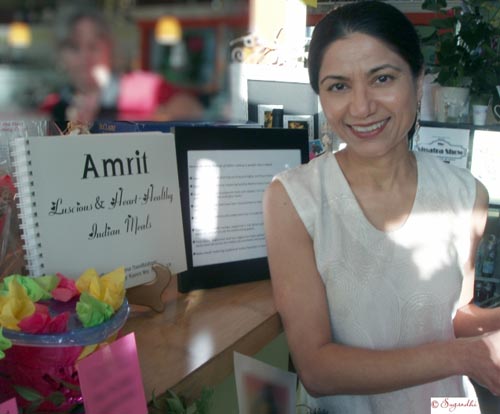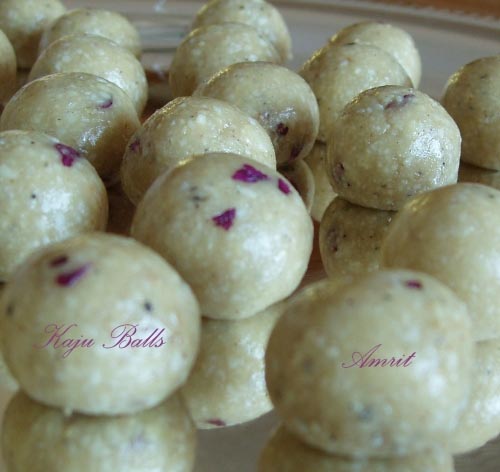
It Need not be a Food-Fight between Healthy & Tasty
When Nanda Nandkishore, a hi-tech professional in San Francisco, went for a complimentary advanced heart risk screening test that was being offered to the TiE charter members, he was shocked to find that most of the results in his test turned out to be in the ‘High Risk’ category.
Nanda and his wife Purnima, who was in microbiology before switching to business, had both come to the US to pursue higher education, and had become successful professionals, like a lot of their friends. They found that the risks for heart disease were something many of them had.
“A lot of Nanda’s friends, who were in the same age group, are struggling with high cholesterol problems,” says Purnima “ Some have had heart attacks, while some have adopted a healthier lifestyle and are controlling the risks without having reached a stage of heart attack or stroke.”
According to the World Health Organization, by 2010, 60% of the world’s cardiac patients will be Asian Indian. The scary part is we are already in 2010! Indeed South Asians are predisposed by genetics for a higher probability of heart disease, but the lifestyle and diet habits can have a huge impact on whether they actually get the disease.
Other statistics are also grim: According to CDC, in 2008, Asian Indians adults had twice the prevalence (14%) of diabetes compared with other Asian populations living in the United States (Chinese, 6% and Japanese, 5%). According to the adults surveyed, 21% reported having hypertension and 9% reported having heart disease.
For the Nandkishores, the change in lifestyle came when Nanda sat down with his cardiologist to discuss controlling his risk factors. The cardiologist suggested statins, a regular exercise routine, and modifications in his diet.
“Nanda asked whether he could try exercise and diet first before getting on statins, so, we sat down with the dietitian who works with the cardiologist, and she gave us a framework to start looking at different foods – the good, the not-so-good, and the ugly,” says Purnima.
“Nanda himself wanted the change, and was willing to put in the required effort to make it happen. The key is that the individual has to want the change to happen from the inside.”

Cooking Heart Healthy Meals
Since Purnima loves to cook and experiment with flavor combinations, she decided to help her husband change his diet by using a different set of ingredients to come up with the same taste and texture sensations to make the traditional foods. She turned to reading different medical studies and pulled in important factors from the Modified Cretan Diet, the OmniHeart study as well as ingredients from Ayurveda. She says, “So my recipes evolved and my kitchen become a fusion cooking experiment station.”
The changes in Nanda’s lifestyle after following this diet have been dramatic. He has lost over 10 lbs over the last five years, has better stamina for hiking and other physical activities, and also has a better physique, a welcome side-effect.
You can look at the result as a progression in reduction of risk factors – the chart is available online at: http://www.amritforheart.com/story.html.
Purnima decided to create a cookbook that would help others to get a heart healthy diet, while maintaining the flavors of traditional Indian cuisine. ‘Amrit: Luscious and Heart Healthy Indian Meals’ was the result.
Since some of the recipes used canned fish as fresh was unavailable in many places, she was concerned about the salt content which would not be acceptable for those trying to control heart disease. To make sure she got the most thorough and analytic information she contacted Dr. Frank Sacks at Harvard University who was Chair of the Design Committee of the DASH study (Dietary Approach to Stop Hypertension).
He directed her to Karen Yee who had worked on DASH and OmniHeart (a follow-up study that looked at the ideal proportions of food for lowering risk factors that lead to heart diseases). So each recipe has a detailed nutritional analysis by Yee, who is a senior research dietician at Brigham & Women’s Hospital.
Purnima, with her background in microbiology and interest in healthy eating, also did a lot of researching to fine-tune Nanda’s diet. She was particularly inspired by The Alameda Seven Study in which 7,000 people in Alameda County (CA) were studied for 25 years for these 7 habits.
The Seven Habits
- Adequate sleep, 7-8 hours per night;
- Regular vigorous physical activity (3 kcal/kg/day)
- Maintaining recommended weight
- Not smoking
- No or Moderate alcohol
- Eating breakfast daily
- Eating meals daily – not grazing
The study showed that by the age 45 a man with:
3 or less habits will live to the age of 67; 4 to 5 habits will live to the age of 73; and 6 to 7 habits will live to the age of 78
Studying the problem of heart disease and South Asians, Purnima found four problems for that community:
Higher stress life. stress is a result of lack of control over things. For new immigrants and for high-striving South Asians it is present in everyday life.
Priorities & Goals. South Asians have set education and material wealth as their goals – physical activity and diet do not show up high on our priorities and goals list (can we name five athletes and five body builders of South Asian origin in the US?
Traditional South Asian Diet is high in carbohydrates, and proportions on our thali are not conducive to good heart-health – a shift to the US usually made the traditional diet worse by adding more refined carbohydrates, and fats easily accessible.
Physical activity level – was moderate when you walked or bicycled your way to school and played badminton after school. Now there is a car to go to work, sit at your desk to do the work and TV to relax with, when you get back from work.
Since Nanda’s success in combating the risk factors of heart disease, Purnima has become an evangelist for lifestyle and diet changes. She gives free talks and writes about heart healthy eating in various publications. She says, “I feel journalists, community and religious heads as well as thought leaders can influence and encourage proactive thinking, open-minded adoption of prevention measures, and promote the use of conscious informed decision making for South Asians.”
Indeed, once one gets used to the changes in diet, it’s hard to go back to the bad old ways. Earlier, Nanda had loved capers with his salmon but now has lost his taste for this salty delicacy and complains that many store bought items are too salty or too sweet for him. Over the last five years he has gotten so used to healthier foods that he no longer likes the rich, deep-fried foods.
Popular Myths – Heart Disease & Indian Cuisine
In the book Purnima has a special section for readers from the Indian sub-continent dispelling some popular myths. Many Indian vegetarians feel that since they do not eat animal products, their risk of getting heart disease is less.
She cites a 2003 review which calls Indian vegetarianism “a form of contaminated vegetarianism because this diet allows consumption of excessive amounts of saturated fatty acids and trans-fatty acids, liberal amounts of high-fat dairy products and simple carbohydrates. The practice of deep frying and reusing fried oil, and using ghee (which is made by heating butter), all create oxides – compounds that are harmful to health.”
Other problems with traditional Indian food, as pointed out in ‘Amrit’:
Deficiencies in the vitamins B6 and B12, common among vegetarians, could lead to an over-accumulation of amino acid homocysteine in the blood, known to be a risk factor in heart disease.
Important nutrients like ascorbic acid and folic acid and minerals are lost during the preparation and cooking of Indian food.
Keeping all this in mind, Purnima has adapted foods inspired by OmniHeart Trial and the Modified Cretan Mediterranean Diet. She has also adapted recipes in Amrit to have less salt because Indians are often prone to high blood pressure, one of the risk factors for heart disease and stroke.
While the no-frills ‘Amrit’ is not a beauty queen of a book (it has no photographs but the luscious matching images to the recipes in the book can be found on the website of the book), it does have useful factors about safe cooking practices, tools and equipment and ingredients, even sharing which ones need to be refrigerated and which can be kept in the pantry.
As Purnima observes, the recipes are not short or quickie ones – they are a labor of love and best done with other family members. The dishes are certainly offbeat – there is Begum Ki bhing which is a herring quiche. As you all know, herring is rich in Omega-3 and low in mercury. Each serving provides 1.17 gm of Omega-3 and 88 mg of Omega-6 fatty acids.
The recipe also contains turnip which provides protection against ischemic stroke, often caused by blood clots in the heart. Another ingredient in the dish is Fromage Blanc, which is a smooth and creamy ‘freshly churned makkhan’ substitute but is thankfully full of protein and devoid of fat! So you get the idea – most dishes let you have your tasty desi ‘sawad’ but are full of ingredients which are good for your heart.
The book contains special entrees spotlighting protein such as Gulabi Machli or Smoked Trout, and Sultani Banda or Jack Mackerel Cutlets. The one dish meals include Aloo Methi Frittata or Potato Fenugreek Frittata or Charminar Makke aur Sahjan Ke Tukre – Corn & Drumstick Squares.
There are special sections for North Indian dishes, vegetables, condiments and desserts. How does Kaju Karela – Bitter Melon with Cashews sound? Other unusual flavorful dishes are methi muffins, olive achaar, and spinach and tomato soup. Desserts include such delicacies as Kaju Laddu, and Aamrus Ashcharya – Gingered Mango Surprise.

Indian Desserts a No-No in Heart Disease?
Wondering how you can eat Kaju Laddus (cashew balls) if you are at risk for heart disease? At the end of each recipe Purnima gives a ‘smaran’ or synopsis of the health benefits of various ingredients used. These laddus are made from coconut flour, agave nectar (a natural sweetener) and cashew nuts which are a source of unsaturated fatty acids, tocopherols, squalene and phytosterols which help block cholesterol absorption. Cashews also have a lower fat content than most other nuts, says Purnima. So each ingredient in the book has a fascinating profile of its benefits for the heart. The nutritional breakdown of ingredients is most useful for those trying to find the most heart-friendly eats.
The 50 recipes ensure that even if you are watching out for your heart, you will still get to eat well and enjoy your food. More details at www.AmritForHeart.com
Check out recipes for Punjabi Polenta and South Indian Chutney here

1 Comment
Enjoyed this article and was surprised to find out that Indian cuisine was not heart healthy. I always thought it was!!